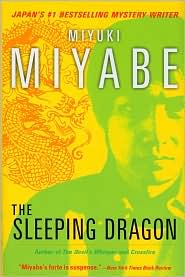Note: Miyuki Miyabe is the “Japan’s #1 bestselling mystery writer.”
“I often get the feeling that we all have a dragon inside, with strange and unlimited powers. Sometimes the dragon is asleep and other times it’s awake; sometimes it wreaks havoc, and at other times it’s under the weather….Once the dragon wakes up and moves into action, we just have to hold on for dear life and hope for the best—it’s not likely that we’ll ever tame it.”
From the outset of this atmospheric, often nail-biting, story, the reader knows that s/he is in the hands of a mastercraftsman, a writer at the peak of her powers who is able to involve the reader in a story of escalating tension and heart-quickening suspense. After only one page, I was completely caught up in the action, holding on for dear life and “riding the dragon” as Miyabe introduced her unusual characters and their even more unusual problems.
of this atmospheric, often nail-biting, story, the reader knows that s/he is in the hands of a mastercraftsman, a writer at the peak of her powers who is able to involve the reader in a story of escalating tension and heart-quickening suspense. After only one page, I was completely caught up in the action, holding on for dear life and “riding the dragon” as Miyabe introduced her unusual characters and their even more unusual problems.
Shogo Kosaka, an investigative reporter at Arrow magazine, is driving through a typhoon late at night, nearly blinded by the rain, when he almost strikes a small, teenaged boy, huddled next to his bicycle on the side of the road. The boy, Shinji Inamura, has a flat tire and is trapped in the storm. When Shogo gives him a lift, they are almost immediately jolted out of their seats. They have hit a submerged manhole cover which someone has removed. Seconds later, a panic-stricken father looking for his seven-year-old son, appears at the scene. His son had run out of the house looking for his cat during the typhoon, and all evidence points to the fact that the boy has now fallen into the water-filled manhole.

When the police suggest that Shogo and Shinji take refuge in a nearby all-night restaurant and small inn, Shogo takes their advice. He is unnerved because Shinji has told him the name of the boy’s cat, the name of the man at the front desk, and personal information about the desk clerk’s relationship with the waitress, things he should have no way of knowing. Later Shinji confides the truth–that he is different, “open,” and he can “scan” people to know what they are thinking. Shinji worries about this ability, which sometimes takes over his whole life. “We [psychics] don’t live very long,” he tells Shogo. “I think it’s too easy to be overwhelmed by the power…Unless you work to control that power, it’ll finish you off.” He has “seen” a red Porsche, whose driver and passenger removed the manhole cover, and he knows the fate of the boy, but though he tells this to Shogo, there is little Shogo can tell the police without compromising young Shinji.
Somehow the author manages to make even a doubter like me “suspend disbelief” and just go with the story, which quickly becomes far more complicated, and involves another psychic teenager who tries to convince Shogo that Shinji is “sick,” a fraud. Gradually, dozens of questions arise, both for Shogo and for the reader. What does the second psychic teenager have to gain by discrediting Shinji? Are they both real psychics? Both frauds? Is one real and the other a fraud? What responsibilities, if any, does Shogo have concerning the two men in the red Porsche who actually removed the manhole cover? Who is sending anonymous notes to Shogo and why? How and why are Shogo’s former fiancée and her husband involved in the action? How can Shogo protect Shinji, and should he protect him? Does Naoya, the second psychic boy, need protection, too? Or is Shogo being used?
The plot often feels like a bad dream from which the dreamer cannot escape. As in dreams, many disparate elements come together in unusual ways. People who don’t seem to belong together somehow do, and plot elements which seem unrelated somehow connect. The reader feels empathy with the characters, and even compassion toward the psychic teenagers. The reader wants Shinji to be real, but at the same time feels sorry for him for having this paranormal power. Shogo, too, is a vibrant character with problems of his own, many of them romantic.
plot often feels like a bad dream from which the dreamer cannot escape. As in dreams, many disparate elements come together in unusual ways. People who don’t seem to belong together somehow do, and plot elements which seem unrelated somehow connect. The reader feels empathy with the characters, and even compassion toward the psychic teenagers. The reader wants Shinji to be real, but at the same time feels sorry for him for having this paranormal power. Shogo, too, is a vibrant character with problems of his own, many of them romantic.
It is a tribute to the author that this novel, which was actually written in 1991, and only recently translated and published into English, is still fresh and exciting today. One of its strongest and most interesting aspects for western readers is its depiction of ordinary Japanese life. When Shogo and Shinji arrive at the small inn at the beginning of the novel, for example, the desk clerk immediately offers to get their wet clothes washed and dried. He gives Shogo clothes and boots of his own to wear so that Shogo can return to the accident scene. The author also illustrates and criticizes snobbish attitudes toward Japan’s “elite” schools, and she refers to problems of compensation for “wronged” parents when an engagement of one of their children is broken. The most striking difference, howe ver, is the constant apologizing by seemingly strong characters, the need to blame themselves when events involving other people do not turn out as expected. Even when a character has no way of preventing a calamity, the character genuinely feels guilty and apologizes profusely for the unexpected.
ver, is the constant apologizing by seemingly strong characters, the need to blame themselves when events involving other people do not turn out as expected. Even when a character has no way of preventing a calamity, the character genuinely feels guilty and apologizes profusely for the unexpected.
Miyuki Miyabe is a prolific author, specializing in mystery, sci-fi, historical, and juvenile fiction. Still in her forties, she has written over forty books, though only five of her adult suspense novels have been translated into English. One of these, All She Was Worth, received the Yamamoto Shugoro Prize in 1993. In 1998, she received Japan’s top prize for popular literature, the Naoki Prize. Gradually, the work of Japan’s “#1 bestselling mystery writer” is finding its way into print in English.
Notes: The author’s photo appears on http://fr.ulike.net/clubs/japonaise
The Ginza, with its famous the Wako clock (photo by Tim Hornyak), features in the novel and appears on www.fuzzyplanet.com
The final photo is of a walkway along the river in Edogawa, where the final scenes take place. www.thetokyotraveler.com
